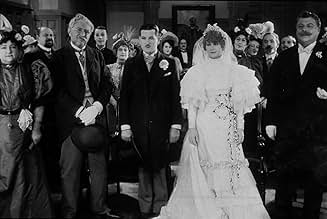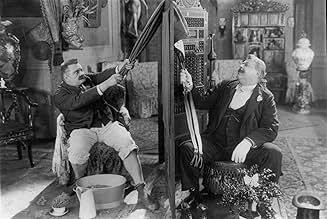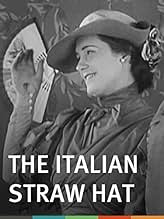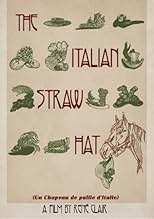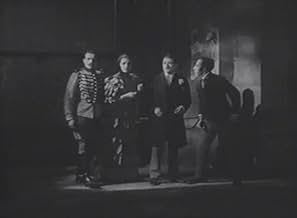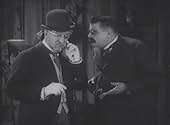IMDb-BEWERTUNG
6,8/10
979
IHRE BEWERTUNG
Füge eine Handlung in deiner Sprache hinzuOn his way through the woods to his marriage, Fadinard's horse eats the hat of a married lady spending here a few moments with her lover. Fadinard has to find the very same rare hat to avoid... Alles lesenOn his way through the woods to his marriage, Fadinard's horse eats the hat of a married lady spending here a few moments with her lover. Fadinard has to find the very same rare hat to avoid her dishonor. This will greatly disturb his own marriage.On his way through the woods to his marriage, Fadinard's horse eats the hat of a married lady spending here a few moments with her lover. Fadinard has to find the very same rare hat to avoid her dishonor. This will greatly disturb his own marriage.
- Regie
- Drehbuch
- Hauptbesetzung
Alice Tissot
- Une cousine
- (as Mme Alice Tissot)
Alexej Bondireff
- Un cousin
- (as M. Alexis Bondi)
Marise Maia
- La mariée
- (as Mlle Maryse Maia)
Yvonneck
- Nonancourt
- (as M. Yvonneck)
Louis Pré Fils
- Cousin Bobin
- (as M. Pré fils)
Albert Préjean
- Fadinard, le marié
- (as M. Albert Préjean)
Geymond Vital
- Le lieutenant Tavernier
- (as M. Vital Geymond)
Olga Tschechowa
- Anaïs de Beauperthuis
- (as Mme Olga Tschekova)
Paul Ollivier
- L'oncle Vézinet
- (as M. Paul Olivier)
Alex Allin
- Félix
- (as M. Alex Allin)
André Volbert
- Le maire
- (as M. Volbert)
Jim Gérald
- Beauperthuis
- (as M. Jim Gérald)
Lya Christy
- Une invitée de la noce
- (as Christie)
Nino Constantini
- Un invité de la noce
- (as Nino Costantini)
A. Debriège
- Une invitée de la noce
- (as Albany Debriège)
Empfohlene Bewertungen
It may sound a bit odd to call a 1927 film a salute to early cinema but as silent film enthusiasts know, movies have been around since before the dawn of the 20th century. The earliest narrative films come from France in the movies of Alice Guy and Georges Melies ca. 1896 and it is those along with the films of French comedian Max Linder that Clair is channeling in THE ITALIAN STRAW HAT. The original source material is a play in the popular French farce style of domestic complications that date all the way back to Moliere.
The year is 1895. A young man on his wedding day must replace a fashionable Italian straw hat which his horse has eaten or face serious consequences from a hot tempered Hussar (the hat belongs to his lover and she can't go home to her husband without it). The director takes this scenario and turns it into a sophisticated comedy of manners a la Oscar Wilde only it's done without dialogue (and very few title cards). While I found it a little too genteel and slow moving at times, THE ITALIAN STRAW HAT still remains a truly great film when you realize what Rene Clair was trying to do and how well he succeeded.
The only other version I had seen of this was an old but decent VHS copy that ran only 84 minutes. This version, at 105 minutes, is not only complete, but it adds little touches that make the film a richer experience. I was struck throughout at how much Albert Prejean (the groom) resembled Charley Chase. In fact this could have made a fine comedy vehicle for Charley. As is now expected of Flicker Alley, the transfer is first rate and the choice of two scores and an informative booklet enhance the presentation.
While Philip Carli's piano score is extremely well done (as they always are), I really enjoyed the Mont Alto Motion Picture Orchestra's chamber score with its liberal use of Offenbach's TALES OF HOFFMANN and Otto Nicolai's MERRY WIVES OF WINDSOR Overture. THE ITALIAN STRAW HAT is the ultimate proof that silent comedy could be sophisticated and delicate and, in the hands of a gifted director like Rene Clair, use subtle visuals to help make the story more vivid. This DVD also comes with Clair's short film on the Eiffel Tower (awe-inspiring) and a short 1907 wedding comedy from Ferdinand Zecca. A must for anyone interested in silent European cinema.
The year is 1895. A young man on his wedding day must replace a fashionable Italian straw hat which his horse has eaten or face serious consequences from a hot tempered Hussar (the hat belongs to his lover and she can't go home to her husband without it). The director takes this scenario and turns it into a sophisticated comedy of manners a la Oscar Wilde only it's done without dialogue (and very few title cards). While I found it a little too genteel and slow moving at times, THE ITALIAN STRAW HAT still remains a truly great film when you realize what Rene Clair was trying to do and how well he succeeded.
The only other version I had seen of this was an old but decent VHS copy that ran only 84 minutes. This version, at 105 minutes, is not only complete, but it adds little touches that make the film a richer experience. I was struck throughout at how much Albert Prejean (the groom) resembled Charley Chase. In fact this could have made a fine comedy vehicle for Charley. As is now expected of Flicker Alley, the transfer is first rate and the choice of two scores and an informative booklet enhance the presentation.
While Philip Carli's piano score is extremely well done (as they always are), I really enjoyed the Mont Alto Motion Picture Orchestra's chamber score with its liberal use of Offenbach's TALES OF HOFFMANN and Otto Nicolai's MERRY WIVES OF WINDSOR Overture. THE ITALIAN STRAW HAT is the ultimate proof that silent comedy could be sophisticated and delicate and, in the hands of a gifted director like Rene Clair, use subtle visuals to help make the story more vivid. This DVD also comes with Clair's short film on the Eiffel Tower (awe-inspiring) and a short 1907 wedding comedy from Ferdinand Zecca. A must for anyone interested in silent European cinema.
"Un Chapeau De Paille D'Italie" can be considered, by this German count's standards, as a transgressor silent film in spite of its classical conventionalism; this particular Teutonic riddle has a Germanic and even logical explanation that will be understood by the longhaired silent youngsters around the world right now.
"Un Chapeau De Paille D'Italie" was directed by the great but French silent director Herr René Clair in the silent year of 1928, after he had directed important, avant-garde, experimental and overall, non conventional silent oeuvres such "Entr'acte" (1924), "Paris Qui Dort" (1925), "Le Voyage Imaginaire" (1925) or "La Tour" (1928); so, having this in mind, then the Germanic assessment mentioned before by this Herr Graf has a solid basis. "Un Chapeau " is a completely different and classic film in comparison with those earlier Clair films and this doesn't mean that "Un Chapeau " is a minor work in Herr Clair 's career; on the contrary, the film is a remarkable, stylized and even provocative comedy.
The incident of the Italian straw hat occurs just before our hero marries, and leads to a series of well placed and paced episodes. The elegant and hilarious scenes depicting the troubles and crossed situations among the just married couple and their wedding guests with the adulterous couple, achieve very remarkable moments. The skillful use of the camera emphasizes the rhythm depending the different scenes, and includes the camera tricks and techniques that Herr Clair was so fond of. The result is a vigorous and sophisticated comedy with a irreverent undercurrent subject in the main plot: a just married man must assume the complicated task of protecting an adulterer.
Helping our hero in such a hazardous mission are excellent supporting actors, playing peculiar characters who are involved unnoticed in this peculiar wedding and will suffer the happenings around the Italian straw hat, a hilarious gallery of guests who have had the misfortune to be part of such a troublesome wedding.
The film is placed at the end of the old XIX century probably in order to take advantage of the human behaviours and fashion of those old times in which the ladies wore elegant hats ( those fräuleins of nowadays showing their loose hair in public!, Mein Gott! ). There is a careful atmosphere of ancient and decadent custom ( faithful characteristics, after all, in Herr Clair films ) that suits the film perfectly. Herr Clair has directed a "classic", stylized and cynical silent comedy that has the same original merits of his most experimental early works.
And now, if you'll allow me, I must temporarily take my leave because this German Count must find his Prussian helmet in order to eat his breakfast properly.
"Un Chapeau De Paille D'Italie" was directed by the great but French silent director Herr René Clair in the silent year of 1928, after he had directed important, avant-garde, experimental and overall, non conventional silent oeuvres such "Entr'acte" (1924), "Paris Qui Dort" (1925), "Le Voyage Imaginaire" (1925) or "La Tour" (1928); so, having this in mind, then the Germanic assessment mentioned before by this Herr Graf has a solid basis. "Un Chapeau " is a completely different and classic film in comparison with those earlier Clair films and this doesn't mean that "Un Chapeau " is a minor work in Herr Clair 's career; on the contrary, the film is a remarkable, stylized and even provocative comedy.
The incident of the Italian straw hat occurs just before our hero marries, and leads to a series of well placed and paced episodes. The elegant and hilarious scenes depicting the troubles and crossed situations among the just married couple and their wedding guests with the adulterous couple, achieve very remarkable moments. The skillful use of the camera emphasizes the rhythm depending the different scenes, and includes the camera tricks and techniques that Herr Clair was so fond of. The result is a vigorous and sophisticated comedy with a irreverent undercurrent subject in the main plot: a just married man must assume the complicated task of protecting an adulterer.
Helping our hero in such a hazardous mission are excellent supporting actors, playing peculiar characters who are involved unnoticed in this peculiar wedding and will suffer the happenings around the Italian straw hat, a hilarious gallery of guests who have had the misfortune to be part of such a troublesome wedding.
The film is placed at the end of the old XIX century probably in order to take advantage of the human behaviours and fashion of those old times in which the ladies wore elegant hats ( those fräuleins of nowadays showing their loose hair in public!, Mein Gott! ). There is a careful atmosphere of ancient and decadent custom ( faithful characteristics, after all, in Herr Clair films ) that suits the film perfectly. Herr Clair has directed a "classic", stylized and cynical silent comedy that has the same original merits of his most experimental early works.
And now, if you'll allow me, I must temporarily take my leave because this German Count must find his Prussian helmet in order to eat his breakfast properly.
10insomnia
I recently saw "The Italian Straw Hat" for the second time; on the silver screen yet! The plot is simple.A horse chews up a lady's straw hat.Her escort demands that it be replaced. This leads to all manner of complications. Slight? Perhaps. Funny? Absolutely hilarious - with not a word spoken!! If any reader gets a chance to see this film, or Clair's 'American' films - "The Ghost Goes West", "And Then There Were None", and: "I Married A Witch" - DO!
Report from Cinesation 2006: AN Italian STRAW HAT (***) Rene Clair had a huge reputation in the early days of sound, and though it's not hard to see why, it is hard to see why the same critics who loved his films (often voting them onto the early Sight & Sound lists of the best films of all time) were dismissive of great Hollywood comedies with exactly the same virtues. (A Nous la Liberte and Le Million are delightful, for instance, but in no way that Duck Soup and Top Hat aren't equally or more delightful.)
This-- based on a perennial stage farce about the complications that follow when a horse eats a married woman's hat while she's off dallying with her lover-- is skillful enough, and it has a few very funny moments, but made mostly in medium or longshot with little subtlety in the playing, it seemed far more primitive for 1927 than, to pick one American comedy, Kiki (shown earlier the same day)-- and the audience at Cinesation didn't laugh nearly as often, either.
This-- based on a perennial stage farce about the complications that follow when a horse eats a married woman's hat while she's off dallying with her lover-- is skillful enough, and it has a few very funny moments, but made mostly in medium or longshot with little subtlety in the playing, it seemed far more primitive for 1927 than, to pick one American comedy, Kiki (shown earlier the same day)-- and the audience at Cinesation didn't laugh nearly as often, either.
I should point out from the outset that I was probably in the wrong frame of mind for a movie like this. Today was a pretty extreme example of "one of those days" for me. I sat down to watch this, definitely wanting a laugh. But any movie was going to have to work extra hard to get a laugh out of me on this crappy day, and this one didn't really do the job. I should have probably gone with something simple and sure-fire, like a Buster Keaton movie, or a Woody Allen, or a Monty Python. Or maybe I should have just gone for a long bike ride. But I watched this instead.
This is one of those society comedies, with a large cast of characters, and various complicated goings on. Most of the humor derives from people trying to put a normal happy face on for the benefit of society, while meanwhile things are spinning out of control beneath the surface. It reminded me a little bit of Fawlty Towers, with John Cleese, for some reason. It's the same kind of humor. You've probably seen a lot of the gags in 10,000 TV sitcoms by now, but I suppose this stuff was a lot fresher in 1927. And most of it was pretty well done, I'll admit.
The story itself is simple, but you have to pay a lot of attention to keep track of all the moment-to-moment details. And I guess that's where the movie failed for me today. My mind kept wandering, and I'd have to rewind the tape to figure out what was going on, and I'd get annoyed. I was really feeling the lack of dialogue in this one. I watch a lot of silent films. They appeal to me for some reason I can't explain. But this movie felt incomplete to me. I felt it would have worked better as a talkie. But maybe it was just the mood I was in.
Anyway, there were several individual scenes that I thought were brilliant, and definitely made me sit up and take notice. One was worthy of a Seinfeld episode: it's a wedding scene; a woman notices her husband's necktie is undone, and she repeatedly nudges him and fiddles with her neck. The husband takes no notice. He sits there like a lump. But another character instinctively reaches to check his tie. This starts a chain reaction, and pretty soon everyone in the church is checking their ties, except for the husband, who's still sitting there oblivious. Another great scene is when the groom at the wedding imagines the angry military man back at his house, vandalizing everything, tossing all his possessions out the windows, tearing down walls--the film lapses into total surrealism; this is Rene Clair at his visual best. I love this scene.
For now, I'm going to rate this a 7/10. But I'll try to catch it again some day, when I'm in a better and more attentive mood, and I think I'll like it a lot better.
This is one of those society comedies, with a large cast of characters, and various complicated goings on. Most of the humor derives from people trying to put a normal happy face on for the benefit of society, while meanwhile things are spinning out of control beneath the surface. It reminded me a little bit of Fawlty Towers, with John Cleese, for some reason. It's the same kind of humor. You've probably seen a lot of the gags in 10,000 TV sitcoms by now, but I suppose this stuff was a lot fresher in 1927. And most of it was pretty well done, I'll admit.
The story itself is simple, but you have to pay a lot of attention to keep track of all the moment-to-moment details. And I guess that's where the movie failed for me today. My mind kept wandering, and I'd have to rewind the tape to figure out what was going on, and I'd get annoyed. I was really feeling the lack of dialogue in this one. I watch a lot of silent films. They appeal to me for some reason I can't explain. But this movie felt incomplete to me. I felt it would have worked better as a talkie. But maybe it was just the mood I was in.
Anyway, there were several individual scenes that I thought were brilliant, and definitely made me sit up and take notice. One was worthy of a Seinfeld episode: it's a wedding scene; a woman notices her husband's necktie is undone, and she repeatedly nudges him and fiddles with her neck. The husband takes no notice. He sits there like a lump. But another character instinctively reaches to check his tie. This starts a chain reaction, and pretty soon everyone in the church is checking their ties, except for the husband, who's still sitting there oblivious. Another great scene is when the groom at the wedding imagines the angry military man back at his house, vandalizing everything, tossing all his possessions out the windows, tearing down walls--the film lapses into total surrealism; this is Rene Clair at his visual best. I love this scene.
For now, I'm going to rate this a 7/10. But I'll try to catch it again some day, when I'm in a better and more attentive mood, and I think I'll like it a lot better.
Wusstest du schon
- WissenswertesRestored in April 2016 through a partnership between the Cinematheque Francaise and the San Francisco Silent Film Festival, with the support of the CNC and Arte France. The new 4K restoration is based on the René Clair's original camera negative which is preserved at the Cinematheque Francaise.
- PatzerAfter the chair has been loaded onto the cart in a medium shot, the next long shot shows it in a different position.
- Alternative VersionenThere is an Italian edition of this film on DVD, distributed by DNA srl, "UN CAPPELLO DI PAGLIA DI FIRENZE (1928) + I MARRIED A WITCH (Ho sposato una strega, 1942)" (2 Films on a single DVD), re-edited with the contribution of film historian Riccardo Cusin. This version is also available for streaming on some platforms.
- VerbindungenFeatured in Historia del cine: Epoca muda (1983)
Top-Auswahl
Melde dich zum Bewerten an und greife auf die Watchlist für personalisierte Empfehlungen zu.
Details
- Erscheinungsdatum
- Herkunftsländer
- Sprachen
- Auch bekannt als
- The Horse Ate the Hat
- Drehorte
- Produktionsfirma
- Weitere beteiligte Unternehmen bei IMDbPro anzeigen
- Laufzeit
- 1 Std. 48 Min.(108 min)
- Farbe
- Sound-Mix
- Seitenverhältnis
- 1.33 : 1
Zu dieser Seite beitragen
Bearbeitung vorschlagen oder fehlenden Inhalt hinzufügen


